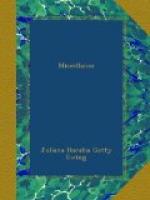Horses and cattle are fed on the leaves of the willow in some parts of France.
Willows are often “pollarded.” That is, their tops are cut off, which makes a large crop of young shoots spring out, giving a shock-headed effect which in gnarled old pollards by river-banks is picturesque enough.
The “little woods” of willow on the river Thames and the Cam are well known. They are small islands planted entirely with willows, and are called osier-holts.
Osier-beds of all kinds are very attractive “little woods.” One always fancies one ought to be able to make something of the long pliable “sally-withys”—as the Wiltshire folk call willow switches. Indeed, as a matter of fact, the making of rough garden-baskets is a very simple art, especially on the Scotch and German system. Let any ingenious little prowler in an osier-bed get two thickish willow-rods and fasten them at the ends with a bit of wire, so as to make two hoops. These hoops are then to intersect each other half-way up, one being perpendicular, to form the handle and the bottom of the basket, the other being placed horizontally, to form the rim. More wire will be needed to fix them in their positions. Much finer willow-wands are used to wattle, or weave, the basket-work; ribs of split osiers are added, and the wattling goes in and out among them, and at once secures them and rests upon them.
This account is not likely to be enough to teach the most intelligent of our readers! But one fancies that a rough sort of basket-making might almost be devised out of one’s own head, especially if he had been taught (as we were, by a favourite nursemaid) to plait rushes.
FOOTNOTES:
[Footnote 1: A corf is a large basket used for carrying coals or other minerals in a mine.]
MAY-DAY,
OLD STYLE AND NEW STYLE.
“Now the bright morning
star, day’s harbinger,
Comes dancing from the East,
and leads with her
The flow’ry May, who
from her green lap throws
The yellow cowslip and the
pale primrose.”—Milton.
On the whole, perhaps, May is the most beautiful of the English months, especially the latter half of it; and yet I suppose very few May-days come round on which we are not disposed to wonder why our ancestors did not choose a warmer, and indeed a more flowery season for Maypoles and garlands and out-door festivities.
Children who live in the north of England especially must have a painfully large proportion of disappointments out of the few May-days of childhood.




